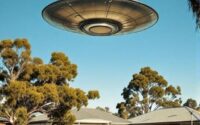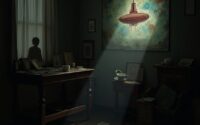The UFOs in the WWII “Foo Fighter” Reports
During World War II, Allied and Axis pilots encountered mysterious aerial phenomena they couldn’t explain. These glowing orbs and discs, dubbed “foo fighters,” performed impossible maneuvers that defied known physics. Military officials initially suspected enemy weapons, but neither side claimed responsibility. The objects didn’t attack—they’d simply observe, follow, and vanish. What these airmen witnessed over war-torn skies would spark decades of debate and forever change how humanity views unidentified aerial phenomena.
Introduction

During World War II, pilots from multiple nations reported encountering mysterious aerial phenomena that defied conventional explanation, sparking decades of speculation about unidentified flying objects in combat zones. These strange sightings, dubbed “foo fighters” by Allied aircrews, appeared as glowing orbs, discs, or lights that’d follow aircraft during missions over Europe and the Pacific. They’d execute impossible maneuvers, accelerate instantly, and vanish without trace. Neither Axis nor Allied forces claimed ownership of these objects, leaving military officials baffled. The phenomena weren’t isolated incidents—hundreds of trained observers documented similar encounters throughout the war. These reports laid the foundation for modern UFO research and continue to intrigue historians, scientists, and researchers who seek rational explanations for what pilots witnessed in wartime skies.
First Allied Pilot Encounters
The earliest documented foo fighter encounters began in November 1944 when Lieutenant Edward Schlueter and radar observer Lieutenant Donald Meiers of the 415th Night Fighter Squadron spotted strange red lights near Strasbourg, France. They reported eight to ten bright orange lights flying at 200 mph in formation alongside their aircraft. The objects couldn’t be outmaneuvered and didn’t appear on radar.
Within weeks, similar reports flooded in from other Allied squadrons. Pilots described glowing spheres that would tail their aircraft for miles, perform impossible aerial maneuvers, and vanish instantly. The 415th alone logged multiple encounters throughout December 1944. Crews initially suspected German secret weapons, but the objects never attacked or showed hostile intent. They’d simply appear, follow aircraft with precision, then disappear without explanation.
Notable Cases or Sightings

While most foo fighter encounters involved brief sightings of mysterious lights, several cases stood out for their detail and credibility. On November 23, 1944, Lieutenant Edward Schlueter and his crew reported orange balls of fire that followed their bomber over Germany, matching every maneuver for nearly ten minutes. The objects didn’t appear on radar despite being clearly visible.
Major William D. Leet’s December 1944 encounter involved a red fireball that circled his B-17 twice before accelerating vertically at impossible speeds. Multiple crew members corroborated his account. Another significant case occurred when RAF pilot Charlie Formby observed silvery discs maintaining perfect formation alongside his squadron over the Rhine Valley. They’d vanish instantly when pursued. These well-documented incidents from experienced airmen couldn’t be dismissed as hallucinations or misidentified aircraft.
Common Theories or Explanations
Military officials and scientists scrambled to explain these bizarre encounters, proposing everything from secret weapons to natural phenomena. The Allies initially suspected Germany had developed advanced aircraft or electromagnetic devices. Similarly, German pilots believed they’d encountered Allied secret weapons.
Natural explanations gained traction post-war. Scientists suggested St. Elmo’s fire, a weather phenomenon creating luminous plasma around aircraft. Ball lightning became another popular theory, as its unpredictable behavior matched many pilot descriptions. Some researchers attributed sightings to combat fatigue and hallucinations under extreme stress.
Reflections from ice crystals at high altitudes could’ve created optical illusions. Venus and other celestial bodies, appearing unusually bright through atmospheric conditions, potentially confused exhausted airmen. These conventional explanations didn’t satisfy all investigators, especially given the consistency of reports across different theaters.
Frequently Asked Questions
Did Axis Pilots Also Report Seeing Foo Fighters During Their Missions?
Yes, Axis pilots also reported seeing foo fighters. German and Japanese aircrews encountered mysterious glowing objects during missions, initially believing they were Allied secret weapons. They’d documented similar unexplained aerial phenomena throughout the war.
Were Foo Fighters Ever Successfully Photographed or Filmed During WWII?
No authenticated photographs or films of foo fighters from WWII have surfaced. While aircrew reported numerous sightings, they couldn’t capture these phenomena on camera despite some attempts. The military’s gun cameras didn’t record any conclusive evidence.
Did Any Foo Fighters Ever Cause Actual Damage to Allied Aircraft?
No foo fighters ever caused documented damage to Allied aircraft during WWII. While pilots reported these mysterious lights following their planes and performing unusual maneuvers, they didn’t attack or physically harm any aircraft or crews.
What Happened to Official Military Foo Fighter Reports After the War?
Military officials classified most foo fighter reports after WWII ended. They’ve transferred some documents to national archives while others remain restricted. Researchers can’t access many original reports, though declassified portions occasionally surface through Freedom of Information requests.
Have Any WWII Foo Fighter Witnesses Changed Their Stories Over Time?
Some WWII foo fighter witnesses have embellished their accounts over decades, adding details about alien origins or advanced technology that weren’t in original reports. However, most veterans who’ve discussed their experiences maintained consistent basic descriptions.


